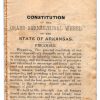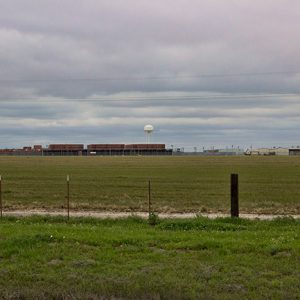calsfoundation@cals.org
Cummins Prison Strike of 1974
The Cummins prison strike of 1974 was a non-violent incident involving 200 inmates who stopped work for twenty minutes on Monday, October 14, to protest conditions at the Cummins prison farm. At 1,350 inmates at that time, Cummins—located five miles southeast of Grady (Lincoln County)—was the largest of the Arkansas prison farms. The strike was swiftly stopped by Cummins superintendent Art Lockhart, who used riot guards to ensure that prisoners returned quickly to work without any violence. By Tuesday, Cummins had returned to normal. The strike revealed that inmates could peacefully protest at that time without fear of severe physical punishment. It also showed that unrest still existed, and the prisons had more work to do before they achieved compliance with federal laws concerning such institutions.
The strike took place during the administration of Governor Dale Bumpers. Bumpers had continued the efforts of his predecessor, Winthrop Rockefeller, who had made prison reform a centerpiece of his administration. Bumpers sought to put professional workers in charge of the prison farms, and in 1971, he chose Terrell Don Hutto, a Texan, as the head of the Department of Correction. Hutto was a skilled, respected, and experienced administrator. Under his tenure, the penitentiary strove to achieve compliance with federal standards in the wake of the landmark 1970 Holt v. Sarver decision, which had declared the entire Arkansas prison system unconstitutional.
The prisoners at Cummins decided to strike in October 1974 in response to a judicial ruling the week before. On October 10, the U.S. Eighth Circuit Court of Appeals in St. Louis, Missouri, ruled that Arkansas still failed to “provide a constitutional and in some respects even a humane environment.” The ruling overturned a previous one by Judge J. Smith Henley, who in 1973 had ruled that Arkansas had made enough progress to have the prisons returned to Arkansas’s control. The appeals court that overruled him cited overcrowding, brutality and torture, racial discrimination, continued use of trusties (inmate guards), arbitrary work assignments and disciplinary procedures, inadequate food and clothing, and the lack of rehabilitation programs as reasons to rule in favor of the inmates who had brought the case.
Inmates interpreted the ruling to mean that they did not have to work. When the call came at the barracks for prisoners to report for work at 7:30 a.m. on Monday morning, the men refused. Within five minutes, Lockhart had called on additional officers to implement “emergency procedures.” The riot guards were armed with nightsticks but did not have to use them. The threat of force worked, and inmates were soon back in the fields. The rest of the day proved uneventful, though prison officials believed some men worked slower than usual out of protest.
The strike apparently was well planned. Hutto said that there had been “a considerable amount of discussion among some inmates regarding an organized attempt to refuse to work.” Hutto went on to say that prisoners had mistakenly interpreted the appeals court’s ruling to mean that the Department of Correction did not have the authority to enforce order at the prisons. Hutto and Lockhart had proven the inmates mistaken. Late in the day on Monday, the Department of Corrections issued a statement saying that some prisoners had cursed at riot officers and made threats against them and their families during the incident. Disciplinary action was taken against those men.
Public opinion in Arkansas continued to be divided regarding the prisons. The more conservative Arkansas Democrat agreed with Henley’s ruling that Arkansas’s prisons should be free of federal oversight. The more liberal Arkansas Gazette, in contrast, saw the ruling as evidence that the state was failing at reform.
In the wake of the prison scandals that had plagued Arkansas since 1967, the Cummins strike was another in a long line of headlines concerning the problems at the prisons (although this situation had been handled with professionalism). Cummins, however, did not stay out of the news. A few weeks after the strike, two men were shot and injured during an escape attempt.
Despite the appeals court’s ruling and the bad press Cummins received because of the strike, the Arkansas penitentiary had made significant strides toward compliance by this time. Hutto had put down an inmate protest without violence. Without question, the prisons had improved from the days of Governor Orval Faubus’s oversight. Hutto and his predecessors—reformers Bob Sarver and Tom Murton—had transferred power from the trusties to “free world” guards. Hutto was succeeding in his efforts to bring Cummins up to national standards. He had also set up education programs at the prison and worked to make sure inmates lived in cleaner cells and barracks and ate better food. The Arkansas penitentiary, nevertheless, would not be ruled constitutional until 1982.
For additional information:
“Failure in Penal Reform.” Arkansas Gazette, October 15, 1974, p. 6A.
“Henley Overruled; Changes Ordered in Prison System.” Arkansas Gazette, October 12, 1974, pp. 1A, 3A.
“Operations Back to Normal as Inmates Return to Work.” Arkansas Gazette, October 16, 1974, p. 1B.
“Shooting of 2 at Cummins Called Proper.” Arkansas Gazette, October 30, 1974, p. 7A.
“Show of Force Sends Prisoners Back to Work.” Arkansas Gazette, October 15, 1974, p. 1B.
Colin Edward Woodward
Lee Family Digital Archive, Stratford Hall



 Cummins Unit
Cummins Unit 



Comments
No comments on this entry yet.